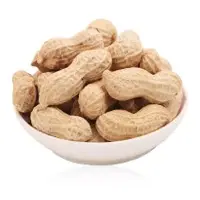

Gotu Kola also acts as a toner for the skin. It tones and tightens the skin if you apply the herb topically. This is the reason why Gotu Kola is found in most of the anti-aging and skin firming creams these days. As this herb can promote collagen production in the human body, it can definitely help in improving the condition of an aging skin, wrinkles and fine lines. - Form: Powder - Part: Whole
Botanical name Phaseolus Vulgaris Taste Typical Odor Odorless. No strange odors Color Dark red, typical Production area Northwest Argentina Under Size 5% Maximum Calibers 160/180, 180/200, 200/220, 220/260 (qty of seeds / 100 g) Packing White polypropylene packaging bag x 25/50 kilos – 50 lbs Loading 20 feet container with 24 Tons ANALYSIS VALUES Purity 99.5 %min Moisture 14.00% max Foreign bodies 0.50% max Insect damage 0.50% max Other sorts 1.00% max Stained grains 1.00% max Slightly stained 3.00% max
Peanut : Nutritional value - eanut fruit contains protein, fat, carbohydrate, vitamin A, vitamin B6, vitamin E, vitamin K, and minerals such as calcium, phosphorus, iron and other nutrients, containing eight kinds of human amino acids and unsaturated fatty acids, , Choline, carotene, crude fiber and other substances. [4-5] fat content of 44% -45%, protein content of 24-36%, sugar content of about 20%. Rich in vitamin B2, PP, A, D, E, calcium and iron. And contains thiamine, riboflavin, niacin and other vitamins. Promote the development of human brain cells, enhance the role of memory.
Formula:KAl(SO4)2 12H2O Relative Molecular Weight:474.39 CAS NO,: 7784-24-9 EINECS No.:5637-689-7 HS CODE.: 2833301000 Appearance: lump, white crystal, white powder Properties:Colorless, transparent, particle or crystalline powder, odorless, nontoxic, tastes slightly sweet and puckery, astringent, easily soluble in water, its water solution appears acid,is would lose crystal water and become white powder on heating Usage; Food industry: Buffering agents and leavening agents in food-grade products. Chemical Industry: Water Flocculant, aluminum tanning agents and after-treating agents for leather tanning in the leather industry, dyeing agents,Astringents,mordants etc. Items Specifications Potassium aluminum sulfate [AlK(SO4)2.12H2O] % 99.5 Plumbum(Pb) mg/kg 5.0 Arsenic (As) mg/kg 2.0 Fluorine (F) mg/kg 30.0 Selenium (Se) mg/kg 30.0 Moisture % 4.0
Popcorn Botanical name Zea mays everata Sturt Taste Typical Odor Odourless, no foreign odours Color Typical, yellow/orange – typical Production area Expansion 38/40, 40/42, 42/44, 44/46, 46/48, Mushroom Packing Paper bags 20kg and 50lb and polypaper bags 20kg and 50lb Loading 20 feet: 25.5 metric tonnes with 20/25kg bags or 24 metric tonnes loading ANALYSIS VALUES Purity 99.5% min Foreign bodies 0.50% max Explosion 98% min Moisture 15.0% max / 12.0 % min Broken/Damaged 1.00% max Insect damage 1.00% max Discolored 0.30% max Undersize 5mm 2.50% max Live insects Free Total Defects 3.5-4.5% max (Deppending on expansión)
Chestnut : Chestnut produces higher energy, is a nut type, contains the starch is very high. According to the investigation of dry chestnut carbohydrates reached 77%, fresh chestnuts have 40%, is the potato 2.4 times; chestnut which is 4% to 5% protein content, although not as peanut, walnut, but also than cooked The rice is taller. Fresh chestnuts contain vitamin C than the recognized vitamin C rich tomatoes to more, it is more than ten times the apple! Chestnut contains a wide range of minerals, potassium, magnesium, iron, zinc, manganese and other content than apples, pears and other common fruit is much higher, especially potassium-containing, than the so-called potassium-rich apple is also 4 times higher The chestnut not only contains a lot of starch, but also rich in protein, fat, B vitamins and other nutrients, heat is also high, chestnut vitamin B1.B2 rich in content, vitamin B2 content of at least 4 times the rice 100 grams also contains 24 mg of vitamin C, which is food can not match. Every 100 grams of protein containing 5.7 grams, 2 grams of fat, carbohydrates 40 to 45 grams, 25 grams of starch. Health chestnut vitamin content can be as high as 40 to 60 mg, cooked chestnut vitamin content of about 25 mg. Chestnut also contains calcium, phosphorus, iron, potassium and other inorganic salts and carotene, B vitamins and other ingredients.
2-Naphthol Basic information Chemical Properties Application Preparation Product Name: 2-Naphthol Synonyms: c.i.37500;c.i.azoiccouplingcomponent1;c.i.developer5;Developer A;Developer AMS;Developer BN;developera;developerams CAS: 135-19-3 MF: C10H8O MW: 144.17 EINECS: 205-182-7 Product Categories: Fluorescent;Naphthalene;pigments;alcohol;MICROCIDIN;Color Former & Related Compounds;Developer;Functional Materials;Intermediates;Aromatic Compounds;Alphabetical;Bioactive Small Molecules;Biochemicals and Reagents;Building Blocks;C9 to C20+;Cell Biology;Chemical Synthesis;Fluorescent Indicators and Probes;Fluorescent Probes;Labels;N;Organic Building Blocks;Oxygen Compounds;Particles and Stains;pH Sensitive Probes and Indicators;Phenols;Dyestuff Intermediates;Aromatics Mol File: 135-19-3.mol 2-Naphthol Chemical Properties Melting point 120-122 C(lit.) Boiling point 285-286 C(lit.) density 1,28 g/cm3 vapor density 4.97 (vs air) vapor pressure 10 mm Hg ( 145.5 C) refractive index 1.5762 (estimate) Fp 153 C storage temp. Refrigerator solubility methanol: soluble1g/10 mL, clear, colorless to light yellow pka 9.51(at 25C) form Powder, Crystals or Granules color White PH Range Non& uorescence (8.5) to blue & uorescence (9.5) Water Solubility 1 g/L (20 C) �»max 226nm, 265nm, 275nm, 286nm, 320nm, 331nm Merck 14,6384 BRN 742134 Stability: Stable. Combustible. Dust may form explosive mixture with air. Incompatible with strong oxidizing agents, phenol. Major Application Display device, semiconductors, photoimaging materials, inks, toner, chalk, security paper, molding materials, tin plating method, rubber, adhesive, leather, detergent, hair dyes, antimitotic drug, anticancer agent, antiinflammatory agent, treatment of acne vulgaris (pimples) and other dermal ailments (rashes, scratches, blemishes, hair loss), disorders InChIKey JWAZRIHNYRIHIV-UHFFFAOYSA-N CAS DataBase Reference 135-19-3(CAS DataBase Reference) NIST Chemistry Reference 2-Naphthalenol(135-19-3) EPA Substance Registry System 2-Naphthalenol (135-19-3) Safety Information Hazard Codes Xn,N Risk Statements 20/22-50 Safety Statements 24/25-61 RIDADR UN 3077 9/PG 3 WGK Germany 2 RTECS QL2975000 F 8 Autoignition Temperature 430 C TSCA Yes HazardClass 9 PackingGroup III HS Code 29071590 Hazardous Substances Data 135-19-3(Hazardous Substances Data) Toxicity LD50 orally in Rabbit: 1960 mg/kg LD50 dermal Rabbit > 10000 mg/kg 2-Naphthol Usage And Synthesis 2-Naphthol Preparation Products And Raw materials





